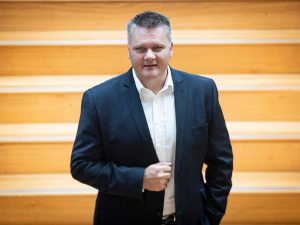Revamped Fonterra to be ‘more capital-efficient’
Fonterra chair Peter McBride says the divestment of Mainland Group is their last significant asset sale and signals the end of structural changes.
 Fonterra chief executive Miles Hurrell told the annual meeting that the co-op had got its balance sheet into a healthier position and can now look more to the future.
Fonterra chief executive Miles Hurrell told the annual meeting that the co-op had got its balance sheet into a healthier position and can now look more to the future.
An efficient New Zealand manufacturing base, diversified markets and a global supply chain helped Fonterra stay ahead of the game during the pandemic.
So said chief executive Miles Hurrell at the co-operative's annual general meeting in Invercargill last week. He claims that, as a result, Fonterra got its balance sheet into a healthier position and can now look more to the future.
"As an intergenerational business, that's incredibly important," says Hurrell.
"We leaned on a number of the co-op's strengths to get us to this position.
"And these strengths have been invaluable as we've faced into the challenges and flow-on effects of Covid."
Hurrell says the NZ manufacturing network and team provided a huge amount of optionality in terms of the products they can make.
"Our people are focused on driving efficiency and improving performance at each of our plants. This continuous improvement creates more value, which flows through into the farmgate milk price."
He claims another huge asset is the co-op's diversification across channels and markets.
Hurrell noted that last year, volumes and earnings were "more or less evenly split" across three regions (Asia/Pacific, Africa/Middle East and Greater China) and three channels (ingredients, food service and consumer).
"This diversification allows us to allocate milk into the products and markets that generate the best overall returns for the co-op," he explained.
In 2021, Fonterra allocated 15% more milk into Greater China and 6% less into Africa/Middle East.
"We did this because that's where demand was the strongest."
Hurrell says Fonterra's third strength is its global supply chain - including Kotahi, a joint venture with Silver Fern Farms.
"It's because of our scale that Kotahi could partner with Maersk shipping line and the Port of Tauranga. And it's because of this partnership that our co-op could continue to get product to our customers last year," he notes.
"With all the disruptions to the global supply chain, this was something our customers didn't take for granted and we saw this reflected in both milk price and earnings."
The National Wild Goat Hunting Competition has removed 33,418 wild goats over the past three years.
New Zealand needs a new healthcare model to address rising rates of obesity in rural communities, with the current system leaving many patients unable to access effective treatment or long-term support, warn GPs.
Southland farmers are being urged to put safety first, following a spike in tip offs about risky handling of wind-damaged trees
Third-generation Ashburton dairy farmers TJ and Mark Stewart are no strangers to adapting and evolving.
When American retail giant Cosco came to audit Open Country Dairy’s new butter plant at the Waharoa site and give the green light to supply their American stores, they allowed themselves a week for the exercise.
Fonterra chair Peter McBride says the divestment of Mainland Group is their last significant asset sale and signals the end of structural changes.

OPINION: Your old mate welcomes the proposed changes to local government but notes it drew responses that ranged from the reasonable…
OPINION: A press release from the oxygen thieves running the hot air symposium on climate change, known as COP30, grabbed your…